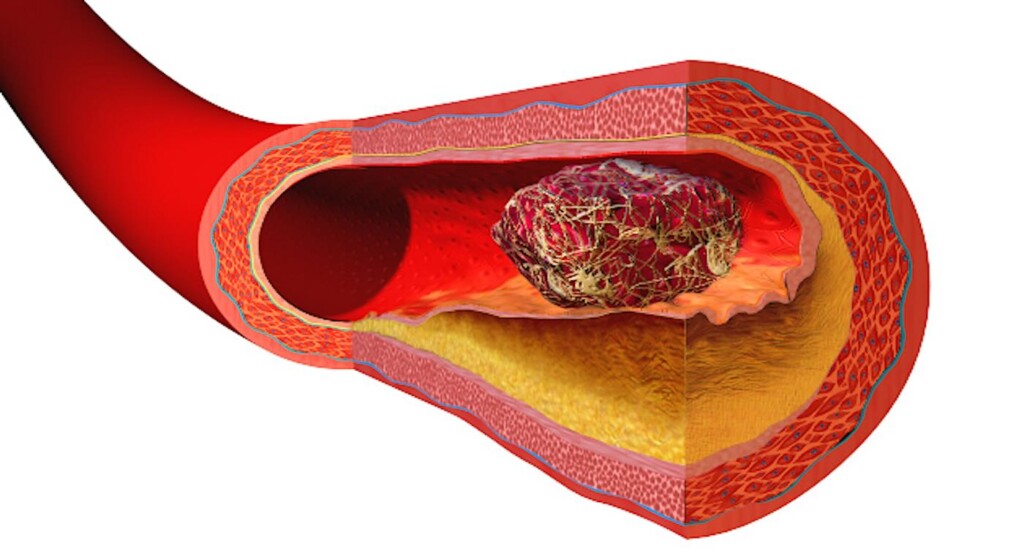 Illustration by Bruce Blaus / Blausen Medical (CC BY 3.0)
Illustration by Bruce Blaus / Blausen Medical (CC BY 3.0)Japanese scientists have found a way to observe clotting activity in the blood as it happens, without needing invasive procedures.
Using a new type of microscope and artificial intelligence, scientists have shown how platelet “clumping” can be tracked in patients with coronary artery disease, opening the door to safer, more personalized treatment.
Platelets are tiny blood cells that rush to plug the severed skin when we suffer a cut.
But they sometimes “overreact” and, in people with heart disease, they can form dangerous clots inside arteries, leading to heart attacks or strokes.
“Platelets play a crucial role in heart disease, especially in coronary artery disease, because they are directly involved in forming blood clots,” said the study’s lead author, Dr. Kazutoshi Hirose, an Assistant Professor at the University of Tokyo Hospital.
To prevent dangerous clots, patients with coronary artery disease are often treated with anti-platelet drugs. However, it’s still challenging to accurately evaluate how well these drugs are working in each individual.
Prof. Hirose and his team developed a new system for monitoring platelets while they are in motion, using a high-speed optical device and AI.
“Just like traffic cameras capture every car on the road, our microscope captures thousands of images of blood cells in motion every second,” said study co-author Dr. Yuqi Zhou, a chemistry professor at the University of Tokyo, in a media release.
“We used an advanced device called a frequency-division multiplexed (FDM) microscope, which works like a super high-speed camera that takes sharp pictures of blood cells in flow. We then use artificial intelligence to analyze those images.”
BETTER THAN SCI-FI: New Electric Bandages Heal Wounds 30% Quicker Than Conventional Dressings
“The AI can tell whether it’s looking at a single platelet—like one car—or a clump of platelets, like a traffic jam, or even a white blood cell tagging along—like a police car caught in the jam.”
The research team applied the technique to blood samples from more than 200 patients.
The findings, published in the journal Nature Communications, revealed that patients with acute coronary syndrome had more platelet aggregates than those with chronic symptoms—supporting the idea that the technology can track clotting risk in real time.
The researchers said that one of the most important findings was that this technique can simply use blood drawn from the arm, rather than from the heart’s arteries, and it can provide nearly the same information.
“That’s exciting because it makes the process much easier, safer, and more convenient,” said Dr. Hirose.
“Typically, if doctors want to understand what’s happening in the coronary arteries, they need to do invasive procedures, like inserting a catheter through the wrist or groin to collect blood.”
BREAKTHROUGH: Blood Test That Detects Sepsis in 10 Minutes by Squeezing Blood Cells – Hailed as ‘the Holy Grail’
“Taking a regular blood sample from a vein in the arm can still provide meaningful information about platelet activity in the arteries.”
The team believes that the technology will help doctors better personalize heart disease treatment.
“Just like some people need more or less of a painkiller depending on their body, we found that people respond differently to anti-platelet drugs. In fact, some patients are affected by recurrent thrombosis and others are suffering from recurrences of bleeding events even on the same anti-platelet medications.
BLOOD TEST FOR STROKES: Researchers Develop a ‘Game-Changing’ Blood Test for Stroke Detection in the Field: ‘Truly Transformative’
“Our technology can help doctors see how each individual’s platelets are behaving in real time (and) AI can ‘see’ patterns beyond what the human eye can detect.”
The study also demonstrates that even something as small as a blood cell can tell a big story about your health.
SHARE THE FANTASTIC MEDICAL NEWS With Science Geeks On Social Media…
Source link

